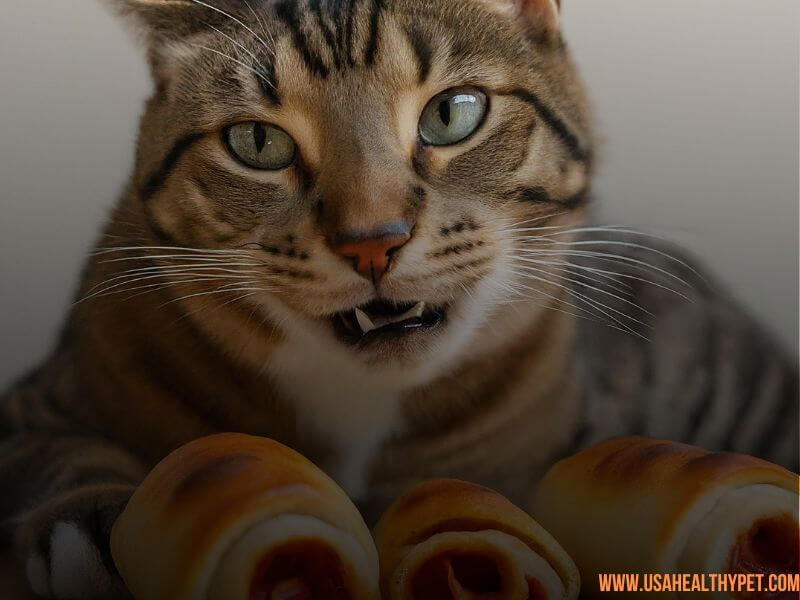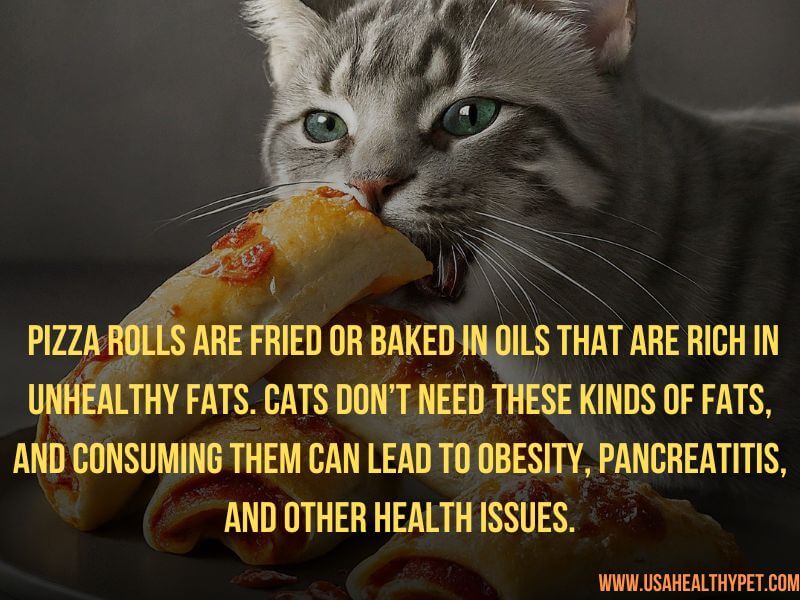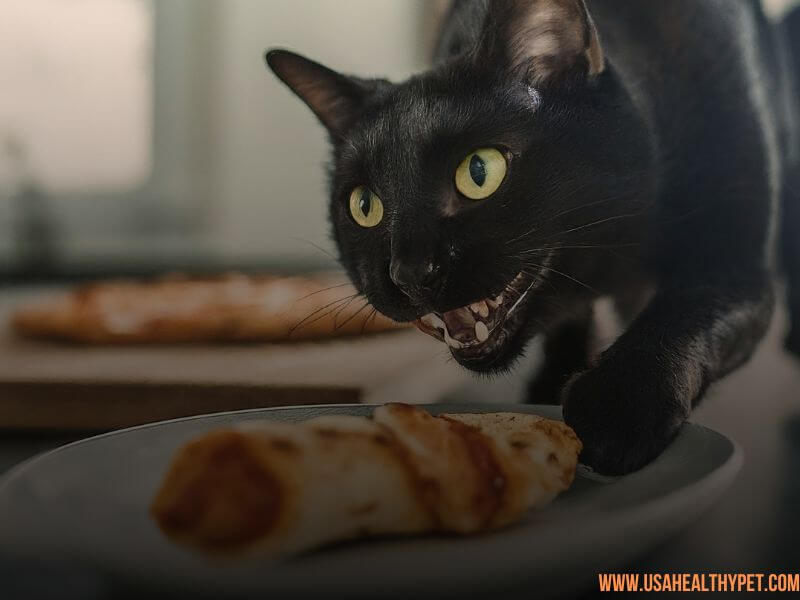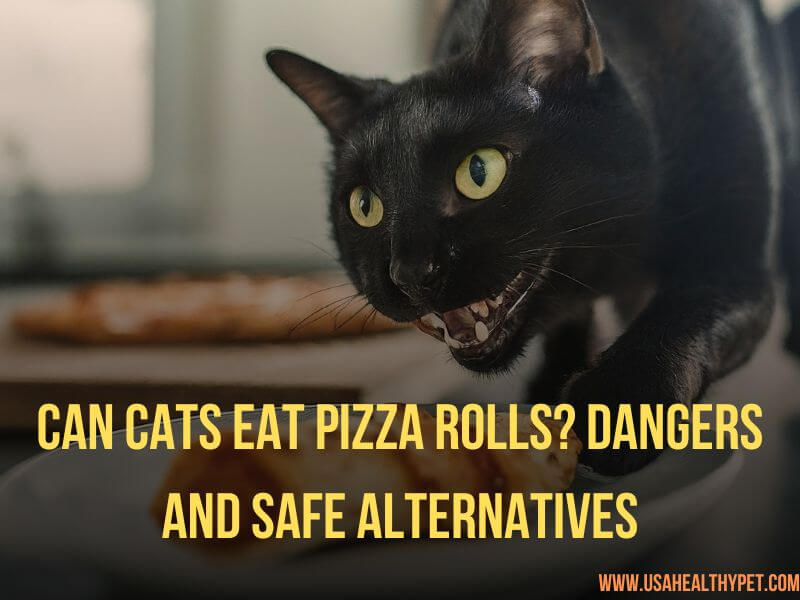Pizza rolls are bite-sized pockets filled with ingredients like cheese, tomato sauce, pepperoni, and spices. For humans, it sounds tasty but for cats these ingredients are harmful.
You might wonder, “Can cats eat pizza rolls?” Cats cannot eat pizza rolls because they contain ingredients that are unhealthy for them. Let’s explore why pizza rolls are dangerous for your cat.
- Why Pizza Rolls Aren’t Safe for Cats?
- What Happens If a Cat Eats Pizza Rolls?
- Why Pizza Rolls Are Bad for Cats
- Specific Ingredients in Pizza Rolls That Are Dangerous for Cats
- Common Signs of Food Intolerance in Cats
- What to Do If Your Cat Eats Pizza Rolls
- Healthy Alternatives to Pizza Rolls for Cats
- How to Prevent Your Cat from Eating Human Food
- Final Thoughts
- FAQs
Why Pizza Rolls Aren’t Safe for Cats?
Pizza rolls contain several ingredients that can pose risks to cats. For starters, the high salt content is a major red flag.
Cats are not equipped to handle large amounts of salt, and consuming too much can lead to serious health problems, such as sodium ion poisoning.
Additionally, pizza rolls are fried or baked in oils that are rich in unhealthy fats. Cats don’t need these kinds of fats, and consuming them can lead to obesity, pancreatitis, and other health issues.
What Happens If a Cat Eats Pizza Rolls?
If your cat happens to get a hold of a pizza roll, you might notice some immediate symptoms of food intolerance or poisoning. These could include:
- Vomiting
- Diarrhea
- Lethargy
- Loss of appetite
- Abdominal pain
If you notice any of these symptoms, it’s crucial to contact your veterinarian right away. They can guide you on the best course of action, which may include bringing your cat in for a check-up or monitoring them closely at home.

Why Pizza Rolls Are Bad for Cats
Let’s dive deeper into why pizza rolls are particularly bad for cats:
- High Salt Content: Pizza rolls are loaded with salt, which can be toxic to cats in large quantities. Salt poisoning in cats can cause vomiting, diarrhea, seizures, and even death in severe cases.
- Unhealthy Fats and Oils: The oils used in frying or baking pizza rolls are not suitable for cats. They can lead to digestive issues and contribute to long-term health problems like obesity and heart disease.
- Harmful Additives and Preservatives: Many processed foods, including pizza rolls, contain additives and preservatives that are not safe for cats. These can cause allergic reactions, digestive problems, and other health concerns.
Specific Ingredients in Pizza Rolls That Are Dangerous for Cats
Several specific ingredients in pizza rolls are particularly harmful to cats:
- Cheese and Dairy Products: Many cats are lactose intolerant, meaning they can’t properly digest dairy products. This can lead to stomach upset, diarrhea, and other digestive issues.
- Garlic and Onions: These ingredients are common in pizza rolls and are extremely toxic to cats. Even small amounts can cause anemia, leading to lethargy, weakness, and other serious health issues.
- Processed Meats and Spices: The meats used in pizza rolls are often highly processed and contain spices that are not suitable for cats. These can irritate their digestive system and lead to long-term health problems.
Common Signs of Food Intolerance in Cats
If your cat consumes something they shouldn’t, you might notice signs of food intolerance or poisoning. Common symptoms include:
- Vomiting and Diarrhea: These are the most immediate and obvious signs that your cat has eaten something they shouldn’t have.
- Lethargy and Loss of Appetite: If your cat suddenly becomes less active or stops eating, it could be a sign of food intolerance.
- Behavioral Changes: Cats may become more irritable or withdrawn if they are feeling unwell due to something they’ve eaten.

What to Do If Your Cat Eats Pizza Rolls
If you catch your cat munching on a pizza roll, don’t panic. Here’s what you should do:
- Call the Vet: Your first step should be to call your veterinarian. They can provide you with advice based on your cat’s symptoms and the amount of pizza roll consumed.
- Monitor Symptoms: Keep an eye on your cat for any signs of distress, such as vomiting, diarrhea, or lethargy. If symptoms persist, take your cat to the vet immediately.
- Consider Dietary Changes: If your cat is prone to eating human food, it might be time to reconsider their diet and feeding habits. Keeping human food out of reach and providing plenty of cat-friendly treats can help prevent future incidents.
Healthy Alternatives to Pizza Rolls for Cats
While pizza rolls are off the menu, there are plenty of healthy alternatives that your cat will love. Consider these options:
- Cat-Friendly Snacks: Look for treats that are specifically designed for cats. These are formulated to meet their nutritional needs and are safe for them to eat.
- Homemade Food Options: If you enjoy cooking, consider making homemade cat treats. There are plenty of recipes available that use ingredients like chicken, fish, and pumpkin, which are safe and healthy for cats.
- Commercial Cat Foods with Natural Ingredients: When choosing cat food, opt for brands that use natural, high-quality ingredients. These foods are better for your cat’s overall health and well-being.
How to Prevent Your Cat from Eating Human Food
To avoid any future mishaps, it’s important to keep human food out of your cat’s reach. Here are some tips:
- Keep Food Out of Reach: Store food in cabinets or on high shelves where your cat can’t access it.
- Train Your Cat: Use positive reinforcement to train your cat to stay out of the kitchen and dining areas. This will help reduce the temptation for them to sneak a bite of your food.

The Importance of a Balanced Diet for Cats
A balanced diet is crucial for your cat’s health. Cats need a diet that is rich in protein, fats, and essential nutrients to thrive. Here’s what you should keep in mind:
- Protein: Cats are obligate carnivores, so they require a diet that is high in animal protein. This supports their muscle development and overall health.
- Fats: Healthy fats are important for maintaining your cat’s coat, skin, and energy levels. Look for foods that contain natural sources of fat, like fish oil.
- Carbohydrates: While cats don’t need a lot of carbs, some are necessary for energy. Make sure any carbs in your cat’s diet come from healthy sources, like vegetables.
Final Thoughts
To sum it all up, while pizza rolls might be a tasty treat for you, they’re not suitable for your cat. Stick to cat-specific foods and treats to keep your feline friend healthy and happy.
Remember, it’s always better to be safe than sorry when it comes to your pet’s diet.
FAQs
Can cats eat any type of human food safely?
Some human foods are safe for cats in small amounts, like cooked chicken or fish, but it’s always best to consult with your vet before giving your cat any human food.
How can I tell if my cat has food poisoning?
Signs of food poisoning in cats include vomiting, diarrhea, lethargy, and loss of appetite. If you suspect your cat has food poisoning, contact your vet immediately.
What are some safe human foods for cats?
Safe human foods for cats include plain, cooked chicken, turkey, and fish. Always avoid giving your cat foods that contain spices, garlic, onions, or excessive fats.
Why do cats like to eat human food?
Cats are naturally curious and may be attracted to the smell and texture of human food. However, this doesn’t mean it’s safe for them to eat.
How do I transition my cat to a healthier diet?
Gradually introduce new foods into your cat’s diet by mixing them with their current food. Over time, increase the proportion of new food until your cat is fully transitioned.

Pingback: Can Cats Eat Bread Crusts? Safety, Risks, and Alternatives
Pingback: Can Cats Eat Tomato Sauce? Dangers, Risks, and Alternatives
Pingback: Can Cats Eat Tortilla Chips? The Surprising Truth